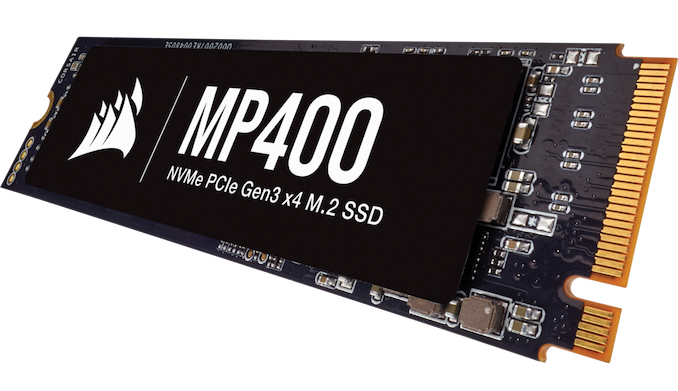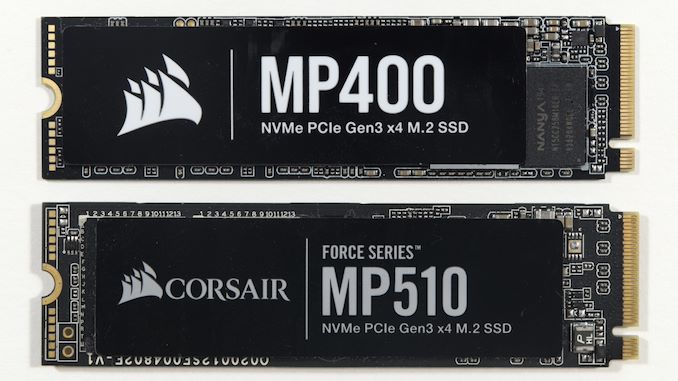The Corsair MP400 1TB QLC NVMe SSD: A Quick Review
by Billy Tallis on December 11, 2020 2:00 PM EST
Following up from our recent look at 8TB QLC SSDs, today we're taking a look at the 1TB Corsair MP400. This is a QLC NVMe SSD using the Phison E12 controller, which puts it a step up from earlier QLC SSDs that used four-channel Silicon Motion controllers. Unlike last week's review of 8TB SSDs, this time we're dealing with a much more affordable capacity of 1TB. At 8TB, many of the downsides of QLC NAND can be overcome by the sheer volume of flash memory, but this 1TB drive falls toward the low end of the QLC SSD capacity range and faces real competition from entry-level drives using TLC NAND.
Corsair MP400
The MP400 is Corsair's answer to Sabrent's Rocket Q and other similar SSDs that have adopted the combination of the Phison E12S controller and QLC NAND. Compared to the Sabrent Rocket Q, Corsair's specifications for the MP400 are a bit more optimistic on performance and a bit lower on the write endurance rating, but we expect the real-world differences between these drives at the same capacity to be insignificant given the near-identical hardware.

Corsair MP400 1TB (QLC) and the Corsair Force MP510 (TLC)
Sabrent's Rocket Q product line covers capacities from 500GB to 8TB. Corsair drops the 500GB option, which is very reasonable: we consider 1TB to be the bare minimum for a QLC drive to make sense. That's especially true of these drives that use an 8-channel Phison E12S controller, half of which goes unused on a 500GB QLC model. Mushkin's recently announced ALPHA series goes even further and will only offer 4TB and 8TB options.
| Corsair MP400 Specifications | |||||
| Capacity | 1 TB | 2 TB | 4 TB | 8 TB | |
| Form Factor | M.2 2280 PCIe 3 x4 | ||||
| Controller | Phison E12S | ||||
| NAND Flash | Micron 1Tbit 96L 3D QLC | ||||
| Sequential Read (MB/s) | 3480 | ||||
| Sequential Write (MB/s) | 1880 | 3000 | |||
| Random Read IOPS (4kB) | 190k | 380k | 610k | ||
| Random Write IOPS (4kB) | 470k | 560k | 710k | ||
| Power Consumption | 4.0 W | 5.5 W | 6.5 W | 6.5 W | |
| Warranty | 5 years | ||||
| Write Endurance | 200 TB 0.1 DWPD |
400 TB 0.1 DWPD |
800 TB 0.1 DWPD |
1600 TB 0.1 DWPD |
|
| Current Retail Prices | $114.99 (11¢/GB) |
$244.99 (12¢/GB) |
$662.00 (17¢/GB) |
$1498.00 (19¢/GB) |
|
The 1TB capacity point is currently the volume spot in the consumer SSD market for QLC, with the most competition and the best prices on a per-GB basis. QLC SSDs have made multi-TB SSDs more affordable, but 2TB and larger drives still tend to carry a premium. In the entry-level NVMe market segment, there's overlap at 1TB between DRAMless TLC designs and QLC with DRAM designs, two markedly different strategies for cutting costs. There are thankfully only a handful of DRAMless QLC NVMe drives that combine both weaknesses. There are also a few relatively budget-oriented TLC SSDs with DRAM that hit low price points using cheaper 4-channel controllers.

Corsair MP400 1TB (QLC, Top) and the Corsair Force MP510 (TLC, Bottom)
Each of these approaches to an entry-level NVMe SSD (QLC+DRAM vs TLC without DRAM) comes with its own typical weaknesses, and some advantages. DRAMless SSDs will suffer under workloads with heavy random IO, but where they do offer decent performance they tend to have very good power efficiency - not having to power any external DRAM chips helps. QLC SSDs suffer most during sustained writes, and are very heavily reliant on their SLC caches. Smaller drives have smaller SLC caches, so it will be much easier to overflow that write cache on this 1TB MP400 than on the larger variants. Most QLC and TLC drives tend to use SLC caches, but QLC drives also tend to use the largest SLC cache sizes possible, which exacerbates the performance problems once the cache is full - there's little or no empty flash left that could be written to directly as QLC, and until the drive can catch a break, further writes will require compacting data from the SLC cache into QLC blocks to free up space.
Most drives using 4-channel controllers have notably limited throughput. SK hynix was first to market with a 4-channel drive that could saturate PCIe 3 x4 (with TLC NAND), and that Gold P31 is priced more like a high-end drive. Silicon Motion has introduced a 4-channel Gen4 controller that is also more than fast enough for a Gen3 x4 interface, but it also is not yet cheap enough for entry-level drives. So for now, the 8-channel Phison E12 controller is the best option for high-capacity QLC SSDs to improve performance.
This review has two main points of comparison for our 1TB Corsair MP400 sample: the 8TB Sabrent Rocket Q we recently reviewed is the most similar, and lets us see how this Phison E12+QLC design scales down to smaller capacities. We also have results for several other 1TB entry-level SSDs, including DRAMless TLC models from Mushkin and Toshiba/Kioxia, and earlier QLC NVMe drives from Intel and Crucial. Unfortunately, we were unable to secure the Western Digital WD Blue SN550 in time for this review; it generally seems to be the best DRAMless TLC drive on the market, and would offer the toughest competition against QLC designs at this 1TB capacity point.
Read on for more analysis.
| AnandTech 2018 Consumer SSD Testbed | |
| CPU | Intel Xeon E3 1240 v5 |
| Motherboard | ASRock Fatal1ty E3V5 Performance Gaming/OC |
| Chipset | Intel C232 |
| Memory | 4x 8GB G.SKILL Ripjaws DDR4-2400 CL15 |
| Graphics | AMD Radeon HD 5450, 1920x1200@60Hz |
| Software | Windows 10 x64, version 1709 |
| Linux kernel version 4.14, fio version 3.6 | |
| Spectre/Meltdown microcode and OS patches current as of May 2018 | |
- Thanks to Intel for the Xeon E3 1240 v5 CPU
- Thanks to ASRock for the E3V5 Performance Gaming/OC
- Thanks to G.SKILL for the Ripjaws DDR4-2400 RAM
- Thanks to Corsair for the RM750 power supply, Carbide 200R case, and Hydro H60 CPU cooler
- Thanks to Quarch for the HD Programmable Power Module and accessories
- Thanks to StarTech for providing a RK2236BKF 22U rack cabinet.














75 Comments
View All Comments
Oxford Guy - Monday, December 14, 2020 - link
850 EVO is 3D TLC built with a fairly large node.rrinker - Tuesday, December 15, 2020 - link
Yes but the point it how much data people write to their SSD, not the technology used. For the intended audience of these slower drives with lower endurance, the point being made here is that the endurance isn't really an issue. For people with use cases where these drives don't really make sense due to plenty of factors other than endurance, it might be an issue, but the people writing that much to the drive aren;t the people this drive is targeted at.Same goes with nearly every review ever posted here. It might be a basic budget product which is more than adequate for Mom and Pop to send emails and view pics of the grandkids, but ALWAYS some extreme user will pipe up with how useless the product is. Well - it's not for you, why should you care? Ma and Pa web browser and emailers don't need 64 core Threadrippers and 128GB RAM and the highest end video card on the market. If you do - then fine, get what suits your needs and ignore the products targeted at users who don't need it. All I'm saying. The key factor here is that this is an older drive and over its lifetime, it hasn't seen anywhere close to even this new drive's rated endurance, and I'm not a casual user. If this drive was around back then, I wouldn't have come close to hitting the limits of it, even though it's rated for far less writes than my 850 due to the technology used.
SodaAnt - Sunday, December 13, 2020 - link
Folding@Home was not the cause, it uses next to no disk.Mobile-Dom - Monday, December 14, 2020 - link
"normal people""Folding@home"
hmm
TheinsanegamerN - Tuesday, December 15, 2020 - link
"normal people"I have a PC with a NVMe SSD. This hosts both several frequently played games and my operating system. Anything that gets downloaded goes to that drive first.
It's a samsung 950 pro. 5 years old, and its just hit 10TBW after hosting god knows how many OS installations. Somehow I find it HIGHLY unlikely you know "normal people" who go through 150TB in 2 months.
Beaver M. - Saturday, December 12, 2020 - link
Been using the same 512 GB SSD for 5+ years now. 12 to 16 hours a day.I have 62TBW now. Thats using it as a system/download/games/recording(not that often) drive.
Given that I didnt install that many different games (since Im a more casual gamer now), 200 TBW seems low. Needs at least 400 TBW, which even my low 512 GB SSD offers, because its MLC.
Its true that if youre a content creator you need much more than that.
Spunjji - Monday, December 14, 2020 - link
Those numbers suggest this drive would last a user like you at least 15 years, and maybe 18. I have doubts that it would even be worth putting into whatever system you're running by then - and that's before we get into the nitty-gritty of what a drive is rated for vs. what it will actually do.TheinsanegamerN - Tuesday, December 15, 2020 - link
So this drive would last you nearly two decades then. And just because you hit the TBW limit doesnt mean the drive stops working. Techreport proved that years ago, and controllers have gotten a lot better since then.https://techreport.com/review/27909/the-ssd-endura...
Beaver M. - Friday, December 18, 2020 - link
It gets a lot slower and there will be NAND fatigue.mukiex - Monday, December 14, 2020 - link
The important thing to note as drives get larger is how important they can be for storing stuff like a Steam library. Game downloads are a read-heavy operation, and cheaper SSD storage with less endurance makes for a perfect storage medium.